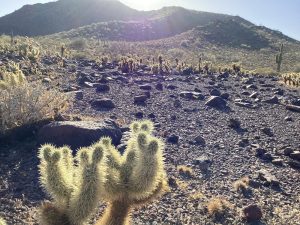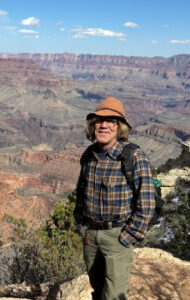 The dying palo verde is poor shade but will have to do. At noon the sky is cloudless, the temperature pushing 100. The tire is a puddle of useless rubber, a dime-sized hole gaping through what’s left of the tread. Pavement lies 15 miles to the north.
The dying palo verde is poor shade but will have to do. At noon the sky is cloudless, the temperature pushing 100. The tire is a puddle of useless rubber, a dime-sized hole gaping through what’s left of the tread. Pavement lies 15 miles to the north.
I stretch out in the gravel wash and stare up at squadrons of bees weaving through the spiky, tangled branches, targeting a few pale yellow blossoms that cling to the tree. Webworms have gobbled every leaf, so photosynthesis will only occur this summer through the thin green bark. Clouds of small flies frolic around my eyes, nostrils and lips, excited by the moisture.
It’s plenty dry out here. Rains are few and far between on this stony chunk of federal land in southern Arizona–a sort of nursery and playground for desert bighorn sheep. A few hundred of the animals make their livings in two roadless, mountain ranges that hide a few scummy waterholes. (The sheep are hunted of course–the refuge would not exist if not for the uniquely human urge to put the heads of dead animals on walls.)
In distant centuries, hunter-gatherers pursued the critters to stay one step ahead of starvation. So important were the sheep in those days that the people managed to find time in their nasty, brutish and short lives to peck bighorn figures by hand into black volcanic boulders. In this century the images live mostly on T-shirts and coffee mugs produced in Asia.
Desert bighorn sheep are rare, secretive beasts. Few humans will ever see one. Like nearly every species of animal in the wild, they harbor a mortal fear of humans. We are apex predators, after all, though most of us have forgotten the skills of the hunt.
We no longer need them. Our technologies have made us like gods. We conjure supermarkets full of food out of cactus-strewn deserts, build shelters with giant machines, weave clothing from processed petroleum.
Everywhere, even under the fiercest desert sun, our miracles bloom. Traffic screams on the interstates, housing developments spread like fungus, bumper crops ripen on irrigation and chemicals, then race around the globe in jets. Our shamans dream of more and better silicon chips. We will have them, we must.
Meanwhile, our noise and dust and numbers continue to rise. The entire world writhes and burns in the fever we have brought on.
To detox from all this success, we stage periodic retreats in “nature”, where we recreate the very conditions we seek to escape. (This place, for example, is a popular winter getaway. Throngs of snowbirds jockey their shiny Jeeps up and down the 4wheel-drive tracks, picnicking and picture-taking. Motorheads run souped-up ATVs where they shouldn’t, terrorizing the local fauna and pulverizing the thin desert soils.)
I used to come here myself in January or February, backpacking the sun-flooded mountains from waterhole to waterhole. I once stepped over a knife-edge ridge to stand eye-to-eye with an indignant bighorn ram, at a distance of ten feet. It leapt to a foot-wide rock shelf a dozen feet below, then bounded out of sight.
I stopped coming here about ten years ago, when it seemed that the Internet had invited the whole world in. I am back today searching for the essence of that moment with the ram, choosing the dread heat of summer because my fellow humans will not.
The desert I love best is a quiet one. That desert is nearly gone, vanishing under the crush of our numbers and our greed. I mourn its passing daily, but betray it with each visit. Sending up my personal plume of carbon dioxide, I return.
I should just stay home. But the hungers–for space, for silence, for the beauty and solace of the nonhuman–are just too strong. There’s no fix for this, and anyone who pays attention knows it. There is too much power at our fingertips, too little generosity in our hearts.
I glance at my truck and can’t help but think the desert might be speaking to me. Stop, it says. Just stop. But the flat tire is just a detail. I’ll be rolling again soon.
Michael Wolcott has lived in the Southwest since 1991. His email address is michaeljwolcott@gmail.com

